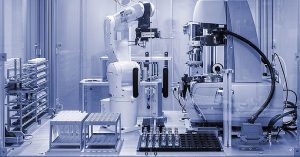
Lab automation refers to the integration of technology and automation techniques in the laboratory setting to improve efficiency, accuracy, and reproducibility. The goal of lab automation is to reduce manual error and increase speed, allowing researchers to focus on more complex tasks.
Lab automation can involve a range of technologies and systems, such as liquid handling robots, automated sample preparation devices, microfluidic systems, and high-throughput screening systems. These systems can automate various laboratory tasks, including sample preparation, reagent dispensing, data collection and analysis, and reporting.
Lab automation can be particularly useful in high-throughput screening applications, where large numbers of samples are processed, and in applications where reproducibility and accuracy are crucial, such as in clinical diagnostic testing.
Before implementing lab automation, it is important to consider the costs and benefits and choose the appropriate technology for the specific application. Implementing lab automation also requires careful planning, including the development of standard operating procedures and the integration of the new systems into existing workflows.
In conclusion, lab automation has the potential to transform the way we do science, increasing productivity and driving scientific discovery and advancements.

